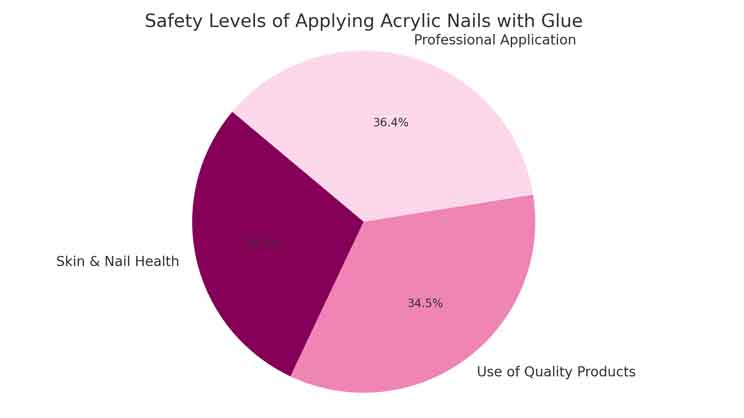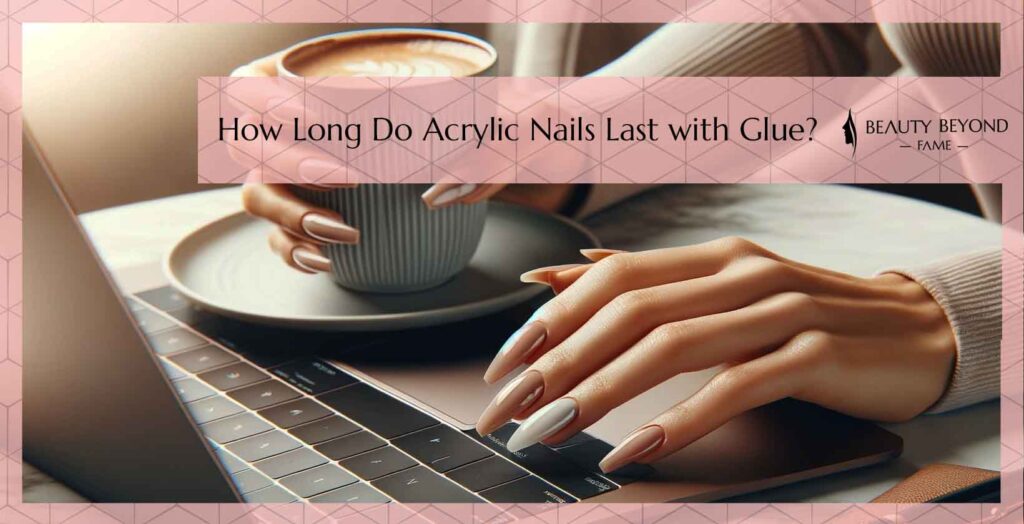Wondering how long you can rock those acrylic nails with the right glue?
Acrylic nails, with a professional nail technician’s application, last 1-6 weeks. Proper aftercare and minimal daily stress can extend their life to 6 weeks; otherwise, touch-ups may be needed sooner.
That’s practically a mini-vacation for your nails from the daily grind.
It’s a little bit of magic right at your fingertips – all thanks to some savvy glue choices.
Just remember, though, they’re not fans of too much splash or tough tasks. Those can send your nails packing earlier than you’d hope.
Ready to get the full scoop?
Let’s dive deeper!
Is it Safe to Apply Acrylic Nails with Glue?

When it comes to jazzing up your nails, acrylics are a go-to for many.
But, pause for a moment and consider: is using glue for acrylic nails a walk in the park or a walk on thin ice?
The truth lies somewhere in the middle.
The Basics
Nail glue, the fairy godmother of acrylic nails, makes sure your stylish add-ons stay put.
It’s strong, fast-drying, and designed for the job. But, like any strong adhesive, it demands respect and careful handling.
Skin and Nail Health
For most, a dab of nail glue won’t turn your nail spa day into a nightmare. Skin irritation or allergic reactions can happen, but they’re not the norm. Keep an eye out for redness, itching, or discomfort around your nails. If your skin throws a fit, it might be time to say goodbye to that glue.
The Professional Touch
A key piece of advice? Don’t turn your home into a DIY nail salon.
Professionals have the know-how and the right tools to minimize any risks. Plus, they can spot if your nails are sending SOS signals, like signs of infections or damage.
So, yes, applying acrylic nails with glue is generally safe if you play by the rules. S
tick to quality products, don’t ignore your skin’s complaints, and let the pros handle the heavy lifting.
Does Acrylic Glue Damage Nails?
The Short Answer is Yes and no. The glue itself isn’t the villain in our story; it’s more about how it’s used and removed.
Think of acrylic glue as that friend who’s a blast to hang out with but can sometimes lead you into mischief.
The Removal Process
Here’s where things get tricky. The removal process can be like a magic trick gone wrong, turning your strong, healthy nails into a fragile mess. It often involves soaking in acetone and can end up stripping away layers of your natural nail if not done correctly.
The Breathing Myth
Your nails, just like you, need to breathe, right? Wrong. This popular myth has been debunked. Nails don’t breathe.
However, trapping moisture between your nail and the acrylic can lead to fungal infections. Not exactly the kind of fungi you’d invite to a party.
Wear and Tear
Over time, the constant cycle of application and removal can lead to weakened nails, prone to breaking and splitting. It’s like using a rubber band over and over; eventually, it loses its stretch.
Acrylic glue, by itself, isn’t a nail nemesis. The real culprits are rough removal techniques and the lack of breaks between applications.
Treat your nails to some TLC, and they’ll stay as tough as a well-cooked steak. Ready to learn how to extend the life of that glue and keep your nails happy? Just say the word!
How to Make Glue Last Longer for Acrylic Nails

So, you’ve got your acrylics on, and they look fabulous.
But how do you keep them that way without having to run to the salon every other day?
The secret sauce isn’t just in the application; it’s in the care.
Prep Like a Pro
Before those acrylics even think about kissing your nails, make sure your nails are squeaky clean. Oil, dirt, or the remnants of your last nail polish can weaken the glue’s grip. Use a gentle nail polish remover, give your nails a good soap-and-water wash, and let them dry completely.
Choose Quality Glue
Not all nail glues are created equal. Do your homework and pick a glue that’s known for its durability. It might cost a few extra bucks, but think of it as an investment in your nail game.
Application Matters
When it comes to glue, think “Goldilocks”: not too much, not too little, just right. A thin, even layer will do the trick. Too much glue can get messy and actually weaken the bond.
Avoid Water Overload
Water is not a friend to your nail glue. Prolonged soaking can weaken the adhesive, leading to premature pop-offs. Wear gloves when doing dishes or cleaning, and try to keep the long, luxurious baths to a minimum.
Touch-Ups are Your Friend
Even with all the care in the world, you might find a corner lifting. Don’t wait for a full-blown nail emergency.
A little touch-up with your trusty glue can extend the life of your acrylics significantly.
Give Them a Break
Lastly, remember your natural nails need to breathe. After a few rounds of acrylics, give your nails a little vacation. It’ll help keep them healthy, ensuring a strong foundation for your next nail adventure.
Keeping your acrylics firmly in place is all about the prep, the product, and the protection.
Follow these steps, and you’ll be rocking flawless nails for weeks on end.
Drawbacks of Wearing Acrylic Nails with Glue

Acrylic nails can transform your hands into a work of art, but even the most beautiful paintings have their challenges.
Let’s peel back the layers and look at the potential downsides of wearing acrylic nails with glue. It’s not all doom and gloom, but awareness is key to keeping your nails happy and healthy.
Risk of Damage to Natural Nails
Acrylics, when applied or removed improperly, can be tough on your natural nails. The main culprits? Over-filing and aggressive removal. These can leave your nails thinner, weaker, and crying out for a break.
The Moisture Trap
Glue and acrylics can create a seal that’s a bit too effective, trapping moisture between the fake nail and your natural nail. This damp, dark environment is like a VIP lounge for fungi and bacteria, leading to infections you definitely didn’t invite.
Allergic Reactions
For some, the chemicals in acrylic nails and glues are more foe than friend. Itching, redness, and swelling around the nails are signs that your body’s not on board with your fashion choice. Listen to your skin; it’s trying to tell you something.
Everyday Hassles
Let’s not forget the practical side of things. Typing, buttoning a shirt, or picking up small objects can become a mini obstacle course. And if an acrylic nail catches on something? Ouch.
Cost and Maintenance
Keeping your acrylics looking A+ requires time, money, and regular visits to the salon. It’s a commitment, not just a one-time fling.
Plus, emergency repairs for breakages or lifts can add up.
Natural Nail Recovery Time
Once you bid adieu to your acrylics, your natural nails might not look like the ones you remember. They could need some TLC and time to recover from the acrylic affair.
Acrylic nails with glue offer a world of style possibilities, but they come with a set of considerations.
Knowing the potential drawbacks helps you make informed decisions, ensuring you and your nails stay on good terms.
Safety Precautions with Nail Glue
Nail glue is like the secret agent in the world of acrylic nails—powerful, effective, but requiring a bit of savvy to handle safely.
Here are some top tips to ensure your mission in nail glam goes off without a hitch, keeping both your style and health intact.
Read Instructions Carefully
Before you dive into your nail transformation, take a moment to read the glue’s instructions. It sounds basic, but understanding the proper application and removal process is crucial for nail health.
Ventilation is Key
Nail glue fumes can be strong, and in a closed space, they can turn your nail session into a headache, literally.
Work in a well-ventilated area to keep those fumes at bay.
Skin Contact: Keep it Minimal
As a Nail Expert, If nail glue could talk, it would probably say, “I belong on nails, not skin.”
Accidental skin contact can lead to irritation or bonding parts you didn’t intend to bond.
A slip-up here could mean a quick trip to get some acetone or, in worse cases, medical help to separate glued skin.
Use the Right Amount
A little glue goes a long way. Overdoing it can not only make your nails look less than perfect but can also increase the risk of trapping bacteria.
Aim for a thin, even layer.
Protect Your Eyes
It sounds like a no-brainer, but keeping glue away from your eyes is crucial.
A splash or accidental rub can lead to a serious situation, fast.
If you do get glue in your eye, seek medical attention immediately—no ifs, ands, or buts.
Have Acetone Handy
For those moments when you need to undo a mistake, acetone is your best friend.
It can help dissolve glue without causing a scene.
Just remember, acetone can be drying, so use it sparingly and follow up with some moisturizer.
Know When to Take a Break
Listen to your nails and your body. If you notice any signs of irritation, give your nails a break from acrylics and glue. Health first, style second.
Professional Intervention
Sometimes, it’s best to leave things to the pros. If you’re unsure about applying or removing acrylic nails with glue, a visit to a good nail salon can save you a lot of stress. It might also save your nails.
Frequently Asked Questions
How do I remove glue-on nails without damage?
To remove glue-on nails safely, soak your nails in warm, soapy water for about 10-15 minutes. This softens the glue. Next, use a wooden cuticle stick to gently lift the edges. If they’re stubborn, soak a bit longer. Avoid pulling or forcing them off to prevent damage. After removal, treat your nails to some moisturizer or oil. Remember, patience is a virtue here, just like waiting for your favorite song to come on the radio.
Can you use super glue for fake nails?
Technically, yes, but should you? Super glue and nail glue share a key ingredient, but super glue is much harsher. It’s like using a sledgehammer for a task that needs a hammer. Sure, it works, but it’s overkill and can harm your nails and skin. Stick to nail glue. It’s made for the job, like using a key for a lock, not a battering ram.
What happens if you put nail glue on a cut?
Imagine putting lemon juice on a paper cut. Ouch, right? Nail glue on a cut stings and can irritate or even infect the wound. Plus, it seals the cut like a misguided band-aid, which sounds helpful but isn’t. Clean the cut and use a proper bandage. Nail glue is a great ally for nails, but it’s not a friend to cuts.
Conclusion
I hope this exploration into the longevity of acrylic nails when applied with glue has provided you with valuable insights.
Now, I’d love to hear from you:
How has your experience been with the durability of acrylic nails?
Do you have any tips or personal insights on making them last longer?
Your experiences and tips are incredibly valuable, not only to me but to our entire community seeking to enhance their nail care routines.
Feel free to share your thoughts in the comments.

